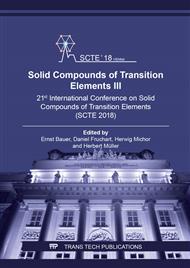[1]
X.L. Yeh, K. Samwer and W. L. Johnson, Formation of an amorphous metallic hydride by reaction of hydrogen with crystalline intermetallic compounds - A new method of synthesizing metallic glasses Appl. Phys. Lett., v. 42, 3 (1983) 242-243; https://doi.org/10.1063/1.93901.
DOI: 10.1063/1.93901
Google Scholar
[2]
K. Aoki and T. Masumoto, Hydrogen-induced amorphization of intermetallics, J. Alloys and Comp. 231 (1995) 20-28.
DOI: 10.1016/0925-8388(95)01832-8
Google Scholar
[3]
B. Rodmacq, M. Maret, J. Laugier, L. Billard, A. Chamberod, Hydrogen-induced phase separation in amorphous Cu0.5Ti0.5 alloys, I - Room-temperature experiments, Phys. Rev. B 38, 2 (1988) 1105-1115.
DOI: 10.1103/physrevb.38.1105
Google Scholar
[4]
A. Cziráki, B. Fogarassy, K. Tompa, I. Bakonyi, A. Lovas, H.E. Shone, Effect of Hydrogen on the Microstructure of the Amorphous Ni-Zr-P System, Z. Phys . Chem. N.F., 163 (1989) 355-360.
DOI: 10.1524/zpch.1989.163.part_2.0355
Google Scholar
[5]
G Pető, I.Bakonyi, K Tompa, L. Guczi, Photoelectron investigation of the electronic-structure changes in Zr-Ni-Cu metallic glasses upon hydrogenation, Phys. Rev. B 52 (10) (1995) 7151-7158.
DOI: 10.1103/physrevb.52.7151
Google Scholar
[6]
V.M. Avdyukhina, A.A. Kantsel'son and G.P. Revkevich. Oscillating phase transformations at the initial stage of relaxation in the hydrogen-saturated alloy Pd-Er, Crystallography Reports, 44 (1) (1999) 1-4.
Google Scholar
[7]
V. M. Avdyukhina, A. A. Anishchenko, A. A. Katsnel'son, G. P. Revkevich, Specific Features of the Hydrogen-Induced Discrete (Jumplike) Structural Evolution in Pd–Ta–H and Pd–Mo–H Alloys, Physics of the Solid State, 47 (3) (2005) 397-423.
DOI: 10.1134/1.1884695
Google Scholar
[8]
V.A. Volkov, V.I. Ladyanov, V.S. Tsepelev. Specific features of the surface and volume crystallization of the ribbon from the amorphous alloy Fe76.1Nb3.0Cu1.0Si13.8B6.1, Metals (Pleiades Publishing, Inc.) 6 (1998) 37-43.
Google Scholar
[9]
Yu.A. Popov, Theory of interaction of metals and alloy with corrosion-active medium, M. J. Nauka. (1995).
Google Scholar
[10]
G.V. Samsonov, The Oxide Handbook, Springer, 1973 https://www.springer.com/gp/book/97814615959911973.
Google Scholar
[11]
V.A. Trapeznikov, X-ray photoelectron and X-ray absorption spectroscopy of transition-metal alloys, Avtoreferat dissertatsii doktora fiz. mat. nauk. Sverdlovsk. (1975).
Google Scholar
[12]
O.M. Kanunnikova, N.Ye. Skryabina, F.Z. Gil'mutdinov, A.S. Petrov and V.Ya. Bayankin, Segregation processes in the surface layers of the amorphous alloy Fe78Si13.5B4Nb3.5Cu at electrolytic hydrogenation, Russian Journal of Non-Ferrous Metals, 4 (2000) 57-59.
Google Scholar
[13]
N.G. Кrapivnyi. Application of electrochemical extraction for the study of hydrogenation of metals. Russian Journal of Electrochemistry, 18 (1982) 1174-1178.
Google Scholar
[14]
Y. Yoshizawa and K. Yamauchi, Magnetic properties of Fe-Cb-V-Si-B (M = Cr, V, Mo, Nb, Ta, W). Mater. Sci. Eng., A133 (1991) 176-183.
DOI: 10.1016/b978-0-444-89107-5.50045-9
Google Scholar
[15]
U. Koster, U. Schumann and M. Blank-Bewersdorff, Nanocrystalline materials by crystallization of metal-metalloid glasses, Mater. Sci. Eng., A133 (1991) 611-615.
DOI: 10.1016/b978-0-444-89107-5.50148-9
Google Scholar
[16]
N. Skryabina, D. Fruchart, Soft magnetic alloys with amorphous and ultra-fine grain structure upon loading with hydrogen, J. Alloys and Comp., 423 (2006) 120-122.
DOI: 10.1016/j.jallcom.2005.12.034
Google Scholar


